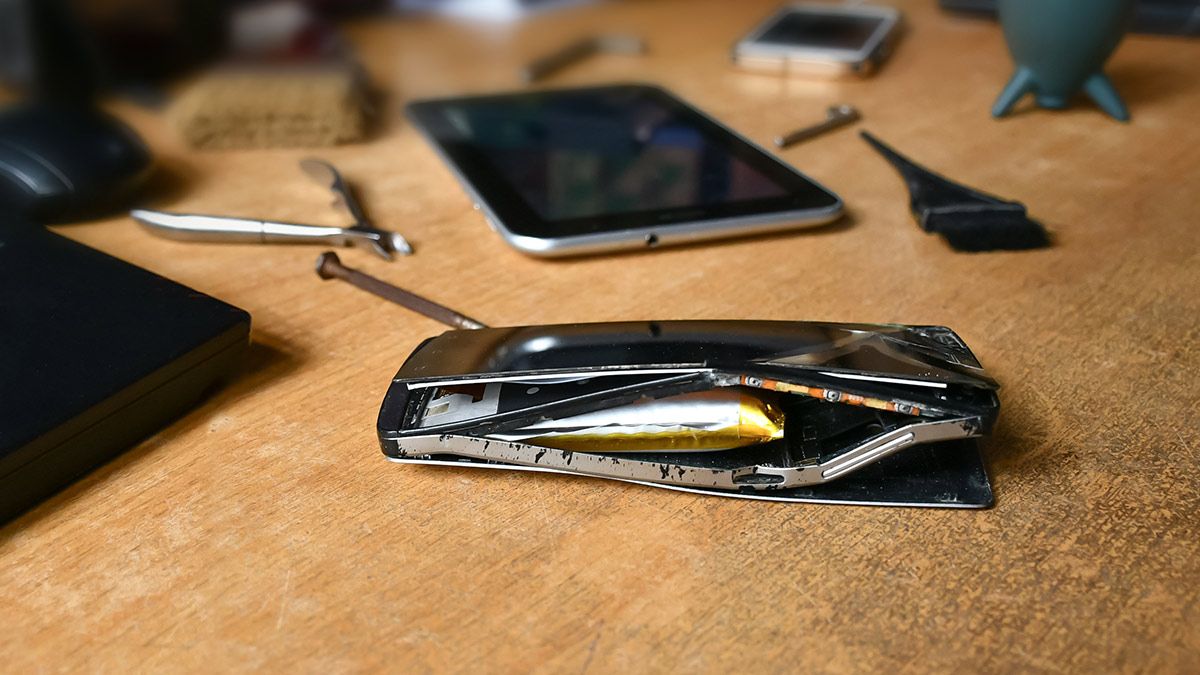Who among us doesn't have a gadget junk drawer or box on a closet shelf with some old phones? Those old gadgets aren't just clutter, though: They're a potential fire hazard. Here's what you need to know.
Before we dig in, if you came across this article because you already have a device with a swollen or bulging battery, please immediately discontinue use of the device, don't attempt to charge it, and read our guide to dealing with laptops, phones, and other devices with swollen batteries.
Why Old Gadgets Are a Fire Hazard
An old Android phone or three here, a forgotten about tablet or two there. It's all too easy to accumulate a pile of old gadgets and gear that you never quite get around to dealing with.
Unfortunately, however, unlike old-fashioned junk drawer gadget castoffs like a flashlight or calculator, modern gear poses a unique risk: it's a fire hazard.
Why? Most modern portable electronics use lithium-ion batteries. Lithium-ion batteries are pretty great in most regards.
They're small, lightweight, and store a good amount of energy for their size. Without them, we wouldn't have super slim smartphones that could go all day (and then some) on a single charge.
But storing a lot of energy in a small space is always a potential risk and lithium-ion batteries aren't exempt from this. As they age and degrade, the chance of a battery failure increases.
Unlike a battery failure with, say, some AA batteries jammed in the back of an old toy, the risk with a lithium-ion battery failing isn't just some leaking and corrosion in the battery compartment, it's a potential fire as the battery swells up and the gases (combined with the stored energy) turn the battery into a potential fireball.
Not only do pictures of dangerously swollen batteries crop up on /r/TechSupportGore fairly frequently, but there's even a whole subreddit devoted to the topic with the tongue-in-cheek name /r/SpicyPillows---a nod to the pillow-like shape of a swollen lithium-ion battery and the fire that can result from damage to the "pillow."
Now, we hardly want anyone to panic at the thought of their forgotten about iPhone 5 or old MP3 player burning their house down while they're reading this article on their lunch break.
Exploding phones are pretty rare, and we should know that keeping a pile of old gadgets around isn't a death warrant. But good gadget management and storage practices can help reduce your risk to nearly zero---and declutter your home in the process.
How to Decrease Your Risk
When it comes to avoiding an old phone or tablet failing and taking your house along for the ride, it's a matter of risk management and minimizing the chance the battery will fail.
Get Rid of Old Gadgets
This might sound like heresy to the folks that keep every gadget, cable, and maybe even the box they came in, forever and ever, but it's certainly a best practice you should consider.
Rather than hold onto old gadgets indefinitely, get rid of them when they are superseded by a new gadget.
Bought a new phone? Perhaps keep the old one for a few weeks as a backup in case your new one is a lemon, but after that safely dispose of it. Sell it, recycle it, give it to a friend or relative to use, but don't just park it in a drawer for so long that when you finally find it someone can declare "It belongs in a museum!" The best time to sell an iPhone, after all, is right when you replace it to take advantage of the iPhone's high resale value.
The same goes for all your other gadgets. Get in the habit of selling, recycling, or donating your old ebook reader, tablet, and even Bluetooth speaker once you replace it with something new. If it has a lithium-ion battery in it and you don't routinely use it anymore, it's time for it to find a new home.
And hey, even if the device was never destined to fail and blow up in your office drawer, it's just good practice to keep gadgets in use and move them along to people who will actually use them.
Charge Your Gadgets Properly
If you're not ready to get rid of the gadget then it's best to charge it properly for storage. Proper charging keeps the battery cells and circuits in optimum health.
While recommendations vary by manufacturer and application, the general consensus is that lithium-ion batteries should be charged to approximately 40%. (Some manufacturers recommend charging 50% or 60% instead.)
Really, the important part here isn't the exact percentage. What's important is ensuring that the battery is charged to roughly half capacity and not stored with a completely discharged or completely full battery.
Discharge rates on lithium-ion batteries in completely powered-off devices are very slow, but you should still plan to top off the charge every 12-18 months or so to keep it around 50%.
Store Them Properly
Gadgets that have made your VIP list for long-term storage deserve proper long-term storage. Just like a myriad of other household things from paints to canned goods, your gadgets will be happiest in a cool dry place.
If you wanted to go above and beyond, a metal storage container with a snug lid on a basement shelf with a desiccant pack inside to control the moisture would offer optimum conditions. However, at that point, if you're not storing them for a very specific reason, you might want to reconsider if it's even worth the effort.
Check On Your Gadgets
One of the biggest themes in the /r/SpicyPillows subreddit is that of people coming across a forgotten gadget and finding it shockingly swollen compared to when they put it away last.
So if you're going to squirrel away old gadgets for whatever purpose, be sure to check on them now and then. (Remember your devices should get a little top-off charge at least once a year or so.)
Battery degradation and swelling rarely happens quickly. Usually, the battery swells slowly until it eventually distorts the case or even cracks the screen it's stuck behind. Checking on your stored devices ensures you catch the swelling in the early stage.
At the first sign your gadget has a failing battery, be sure to properly handle and dispose of the battery by following these guidelines.


